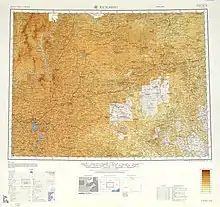K'un-ming
English

Map including K'UN-MING (YÜNNANFU) (AMS, 1954)
Etymology
From Mandarin 昆明 (Kūnmíng), Wade–Giles romanization: Kʻun¹-ming².[1]
Pronunciation
- enPR: ko͝onʹmǐngʹ
Proper noun
K'un-ming
- Alternative form of Kunming
- 1954, Wiens, Herold J., “The South China geographical environment”, in Han Chinese Expansion in South China, Shoe String Press, published 1967, →LCCN, →OCLC, →OL, page 8:
- Settlements at a few favored basins, and strategic outposts were established very early, such as those at Kuei-yang and K'un-ming, but the vast extent of the territory remained under the local autonomous rule of tribal chieftains with nominal subservience to the Chinese Emperor.
- 1969, Norton Ginsburg, Joseph Kitagawa, editor, Understanding Modern China, Quadrangle Books, →LCCN, →OCLC, page 59:
- Ninety-five per cent of the cultivated area of the country lies east of a line drawn from Tsitsihar (Ch'i-ch'i-ha-erh) in northern Manchuria to K'un-ming in Yün-nan Province. This is eastern China, and within it is the Chinese ecumene.
- 2006, Geoffrey Blainey, A Short History of the 20th Century, Ivan R. Dee, →ISBN, →LCCN, →OCLC, page 254:
- Julia Child helped one of the world's richer and more puritanical nations to view its menu afresh. A Californian, she worked for U.S. intelligence in wartime K'un-ming, where the American food she ate was "terrible" and the regional Chinese food was a revelation.
-
Derived terms
Translations
Kunming — see Kunming
References
- Kunming, Wade-Giles K’un-ming, in Encyclopædia Britannica
Further reading
- “K'un-ming” in TheFreeDictionary.com, Huntingdon Valley, Pa.: Farlex, Inc., 2003–2023.
This article is issued from Wiktionary. The text is licensed under Creative Commons - Attribution - Sharealike. Additional terms may apply for the media files.